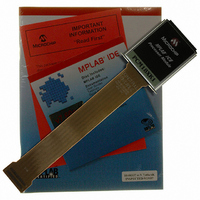PCM18XK1 Microchip Technology, PCM18XK1 Datasheet - Page 25

PCM18XK1
Manufacturer Part Number
PCM18XK1
Description
MODULE PROC PIC18F8680,6680,8565
Manufacturer
Microchip Technology
Datasheet
1.PCM18XK1.pdf
(496 pages)
Specifications of PCM18XK1
Accessory Type
Processor Module
Lead Free Status / RoHS Status
Not applicable / Not applicable
For Use With/related Products
ICE2000
For Use With
ICE2000 - EMULATOR MPLAB-ICE 2000 POD
Lead Free Status / Rohs Status
Lead free / RoHS Compliant
- Current page: 25 of 496
- Download datasheet (9Mb)
2.0
2.1
The PIC18F6585/8585/6680/8680 devices can be
operated in eleven different oscillator modes. The user
can program four configuration bits (FOSC3, FOSC2,
FOSC1 and FOSC0) to select one of these eleven
modes:
1.
2.
3.
4.
5.
6.
7.
8.
9.
10. ECIO+PLL
11. HS+SPLL
2.2
In XT, LP, HS, HS+PLL or HS+SPLL Oscillator modes,
a crystal or ceramic resonator is connected to the OSC1
and OSC2 pins to establish oscillation. Figure 2-1
shows the pin connections.
The PIC18F6585/8585/6680/8680 oscillator design
requires the use of a parallel cut crystal.
2004 Microchip Technology Inc.
Note:
LP
XT
HS
RC
EC
ECIO
HS+PLL
RCIO
ECIO+SPLL External Clock with software
OSCILLATOR
CONFIGURATIONS
Oscillator Types
Crystal Oscillator/Ceramic
Resonators
Use of a series cut crystal may give a fre-
quency out of the crystal manufacturers
specifications.
pin enabled
with PLL enabled
pin enabled
with software control
Low-Power Crystal
Crystal/Resonator
High-Speed Crystal/Resonator
External Resistor/Capacitor
External Clock
External Clock with I/O
High-Speed Crystal/Resonator
External Resistor/Capacitor with
I/O pin enabled
controlled PLL
External Clock with PLL and I/O
High-Speed Crystal/Resonator
PIC18F6585/8585/6680/8680
FIGURE 2-1:
TABLE 2-1:
These values are for design guidance only.
See notes following this table.
All resonators used did not have built-in capacitors.
16.0 MHz Murata Erie CSA16.00MX
2.0 MHz Murata Erie CSA2.00MG
4.0 MHz Murata Erie CSA4.00MG
8.0 MHz Murata Erie CSA8.00MT
Note 1: See Table 2-1 and Table 2-2 for recommended
Mode
Note 1: Higher capacitance increases the stability
HS
XT
C1
C2
2: A series resistor (R
3: R
2: When operating below 3V V
3: Since each resonator/crystal has its own
(1)
(1)
values of C1 and C2.
strip cut crystals.
of the oscillator, but also increases the
start-up time.
using certain ceramic resonators at any
voltage, it may be necessary to use high
gain HS mode, try a lower frequency
resonator, or switch to a crystal oscillator.
characteristics, the user should consult the
resonator/crystal manufacturer for appro-
priate values of external components, or
verify oscillator performance.
F
16.0 MHz
XTAL
R
2.0 MHz
4.0 MHz
8.0 MHz
455 kHz
varies with the oscillator mode chosen.
S
Freq
(2)
Resonators Used:
CAPACITOR SELECTION FOR
CERAMIC RESONATORS
OSC2
OSC1
Ranges Tested:
CRYSTAL/CERAMIC
RESONATOR OPERATION
(HS, XT OR LP
CONFIGURATION)
68-100 pF
15-68 pF
15-68 pF
10-68 pF
10-22 pF
S
) may be required for AT
R
C1
F
PIC18FXX80/XX85
(3)
DS30491C-page 23
Sleep
DD
68-100 pF
15-68 pF
15-68 pF
10-68 pF
10-22 pF
, or when
To
Internal
Logic
0.5%
0.5%
0.5%
0.5%
C2
Related parts for PCM18XK1
Image
Part Number
Description
Manufacturer
Datasheet
Request
R

Part Number:
Description:
Manufacturer:
Microchip Technology Inc.
Datasheet:

Part Number:
Description:
Manufacturer:
Microchip Technology Inc.
Datasheet:

Part Number:
Description:
Manufacturer:
Microchip Technology Inc.
Datasheet:

Part Number:
Description:
Manufacturer:
Microchip Technology Inc.
Datasheet:

Part Number:
Description:
Manufacturer:
Microchip Technology Inc.
Datasheet:

Part Number:
Description:
Manufacturer:
Microchip Technology Inc.
Datasheet:

Part Number:
Description:
Manufacturer:
Microchip Technology Inc.
Datasheet:

Part Number:
Description:
Manufacturer:
Microchip Technology Inc.
Datasheet:










